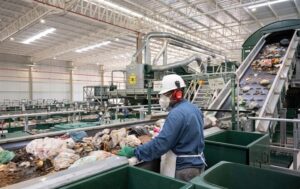
Complete Guide to Circular Economy circular economy rethinks the way we produce and consume, considering that every product must be thought of from its conception to its disposal to be used to its fullest potential, leaving the smallest possible impact on nature.
In this complete guide to circular economy for businesses, you will learn from theory to practice how to apply this method in your company.
What is circular economy
Circular economy proposes a production model that considers the sustainability of the product, from raw material extraction to material disposal.
In this approach, products should be designed to be reused, recycled, and transformed into new inputs, such as in the case of composting and renewable fuels.
To achieve this goal, the public, private, and civil sectors must work together, creating circular products, promoting a culture of conscious disposal, and building a service chain that can properly manage each product.
The history of circular economy
Although the term ‘circular economy’ is relatively recent, the practice of fully utilizing materials has existed for centuries.
If we travel back before the 18th century, the period when the Industrial Era began and with it the linear production we know today, we will see a production model that used all or almost all parts of a raw material to produce products with inputs that could often return to nature.
| Notice the furniture made from wood or clay. It was common for families to compost food scraps. Clothes were made from organic materials, dyed with natural dyes, and reused to the fullest extent. All these examples show that society once lived under a more circular production system. So, what changed? |
It was during the Industrial Revolution that we had technological advances, replacing handicraft with machine manufacturing, prioritizing speed and cheaper production, thus giving rise to the linear economy.
The linear economy operates on the premise that each player manages a part of the process, without considering the sustainability of the production chain. Thus, the manufacturer wants to lower costs without concern for the origin of raw materials or the destination of the product after disposal.
In this way, the Industrial Revolution brought technological advances but also caused massive exploitation of natural resources and environmental pollution due to waste disposal.
There are no precise records of when the official concept of circular economy emerged, but after 1960 the topic began to be discussed in academia and businesses. In a timeline, the key movements that brought the concept into focus were:
1966
In the book The Economics of the Coming Spaceship Earth, Kenneth Boulding introduced the idea of a closed economy, comparing the Earth to a “spaceship” with finite resources, highlighting the need for a circular model that reuses materials and minimizes waste to ensure sustainability.
1989
In the book Economics of Natural Resources and the Environment, David W. Pearce and R. Kerry Turner discuss circular economy by emphasizing efficient management of natural resources, highlighting the need for reuse, recycling, and waste minimization to promote sustainability and reduce environmental impacts.
From 2000 onwards
Companies and governments began to more actively implement circular economy, many inspired by the book Cradle to Cradle by William McDonough and Michael Braungart. However, it was in the mid-2010s that the Ellen MacArthur Foundation popularized the theme globally.
Since then, several concepts such as minimalism, regeneration, and upcycling have helped circular economy develop and today it is considered the economy of the future.
The 3 pillars of circular economy
If your company wants to implement circular economy in its production, it is very important to understand the 3 pillars of this practice: eliminate waste, circulate products and materials, and regenerate nature.
Eliminate waste and pollution
In this pillar, product design is fundamental, since it is through this tool that the company can develop a sustainable piece, which uses the largest part of the same raw material that should preferably be a low environmental impact material.
An example of the Eliminate waste pillar would be a clothing brand that sews its pieces avoiding fabric leftovers and, if there are any, they are used to compose another piece.
We can also think of the food sector, where the company can offer its products using the majority of the food, that is, the raw material, and send leftovers for composting.
Circulate products and materials
Circulating products and materials is the pillar that considers the reuse of inputs or already produced articles. Technology companies, for example, can reintroduce material into their production chain through reverse manufacturing.
To circulate products and materials, it is often necessary to count on companies specialized in reverse logistics and waste management.
Regenerate nature
The Regenerate Nature pillar takes into account that, beyond caring, we need to give back what was taken. This concept is based especially on nature’s spontaneous process, where everything produced returns to the natural cycle.
Regeneration can happen from the start of production, where, for example, more sustainable materials are used, such as natural rubber extraction. Or it can happen at the end of the product’s life, being sent to composting, which can serve as input for agricultural plantations.
Legislation in Brazil that drives circular economy
Circular economy is not just a theory, it is a real concept embedded in global sustainability strategies. In Brazil, there are several laws that regulate and/or encourage companies to adopt sustainable practices in their operations.
These laws aim to promote material reuse and implementation of reverse logistics. The main ones are:
1. National Solid Waste Policy (PNRS) – Law No. 12,305/2010 – Establishes reverse logistics and shared responsibility for the product life cycle, requiring companies to implement solid waste management plans.
2. Decree No. 11,413/2023 – Regulates and strengthens reverse logistics mechanisms, creating Recycling Credit Certificates (CCRLR), Structuring and Recycling (CERE), and Future Mass.
3. National Climate Change Policy (PNMC) – Law No. 12,187/2009 – Establishes guidelines for reducing greenhouse gas emissions, encouraging more sustainable industrial practices such as material reuse and energy efficiency.
4. RenovaBio Program – Law No. 13,576/2017 – Encourages the use of renewable fuels to reduce dependence on fossil fuels.
5. Hazardous Waste Law – Decree No. 10,936/2022 – Regulates the management of hazardous waste, requiring industries to adopt practices that encourage recycling and material reuse.
6. Mover Program – Law No. 14,440/2022 – Stimulates the production of sustainable vehicles, demanding higher energy efficiency and promoting the use of recyclable materials and renewable fuels.
Discover how Orizon can help your company implement waste management actions to comply with Brazilian environmental legislation.
Benefits of circular economy for companies
Companies that adopt circular economy benefit from:
Compliance with Regulations and Tax Incentives
Companies adopting circular economy practices will be more aligned with environmental laws such as the National Solid Waste Policy (PNRS).
This offers the possibility of obtaining environmental certificates and reverse logistics credits, such as CCRLR and CERE, as well as greater legal security and prevention of fines for non-compliance with environmental regulations.
Alignment with Environmental Goals
To meet environmental and sustainable development goals, circular economy becomes a great tool, optimizing company resources, reducing greenhouse gas emissions by lowering raw material extraction, promoting cleaner production, and contributing to carbon neutrality and climate change mitigation goals.
Competitive Differentiation and Brand Reputation
Sustainable companies are viewed favorably by consumers, investors, and business partners.
Companies that adopt circular practices have more opportunities to attract ESG-focused investment funds, participate in government bids and contracts that require sustainable practices, and expand into international markets demanding strict environmental standards.
Competitive differentiation can also attract customers and build loyalty due to the value placed on sustainability.
Engagement and Organizational Culture
Employees feel more motivated working in a company with a sustainable purpose that encourages them to develop creative solutions.
With circular economy at the company’s operational base, it is possible to attract and retain talent who value and are motivated by responsible environmental and social practices, creating a more innovative and sustainability-committed corporate culture.
6 Steps to Implement Circular Economy
If your company wants to implement circular economy, the first action you should take is to change your culture and, instead of the traditional linear production cycle — extract, produce, consume, and discard — you should apply a more regenerative system in your stages, where waste becomes input for new production processes.
| It is important to highlight that although circular economy mainly addresses productive industries, service-based businesses can also apply it, for example, by considering environmentally responsible suppliers and managing their waste well. |
- Start with Small Actions
If the company is already in full operation and wants to establish a new, sustainable, and circular culture, starting with small routine actions is extremely effective to raise awareness in the team about the need for change. Reducing disposable plastic in the office, implementing recycling and composting are interesting actions. - Reduce Waste Generation at the Source
Reevaluate production processes to minimize waste generation. For this, products and services need to be rethought to optimize raw materials, preferably choosing renewable or recyclable inputs. - Reuse and Recycling of Materials are Essential
By adopting the circular economy, the company creates mechanisms to maximize the reuse of materials within its own production chain. Additionally, it is important to structure a reverse logistics plan to ensure products and packaging can return to the production cycle. - Invest in Sustainable Processes
Investing in technologies that improve resource efficiency and reduce waste is essential. The company can implement process digitization, adoption of clean energy, efficient water management, inclusion of green areas, etc. - Create Strategic Partnerships
For the circular economy to function efficiently, having specialized partners can be a differential. Companies like Orizon, which offer innovative waste management and material reuse solutions, help accelerate this transition. Orizon has the expertise in correct waste disposal and valorization, offering solutions that guarantee traceability and environmental certifications, adding credibility to the process and helping strengthen companies’ sustainability area. - Engagement of the Supply Chain and Consumers
Cultural change must also reflect outside the company, with suppliers and consumers. Implementing awareness programs, encouraging sustainable practices, and creating business models that promote reuse are fundamental strategies.
Sustainable Transformation with Specialized Support
By adopting a circular economy model, your company can improve resource efficiency and strengthen its sustainable positioning in the market. With support from strategic partners in waste management and material reuse, this transition can become more accessible and effective.
By investing in the circular economy, companies improve resource efficiency and become sustainability benchmarks. With specialized solutions, like those offered by Orizon, this transition becomes more accessible, efficient, and aligned with environmental legislation.



